Gelli printing has become a favorite among artists for its spontaneity, texture, and endless possibilities. This printmaking technique allows you to create unique prints by using a Gelli plate, which can be used with a variety of materials, including paints, inks, stencils, and more. If you are new to Gelli printing or want to improve your technique, one of the key elements to consider is the type of paint you use.
The right paint can make all the difference in your results, offering better texture, vibrant colors, and crisp designs. We’ll explore the best paint for Gelli printing, how to choose the right paint for your projects, and answer some frequently asked questions to help you get the most out of your Gelli printing experience.
What is Gelli Printing?
Before diving into the best paints, let’s quickly review what Gelli printing is and how it works. Gelli printing is a form of monoprinting where you create one-of-a-kind prints using a gelatin-like plate, typically made of synthetic rubber or gelatin. This plate is used to apply paint, which is then transferred to paper, fabric, or other surfaces by pressing them onto the plate.
The unique feature of Gelli printing is that you can create textured, layered designs by using stencils, masks, stamps, or even found objects to manipulate the paint. The process is incredibly versatile, allowing you to achieve a wide range of artistic effects, from vibrant color blends to intricate patterns and textures.
Why is the Type of Paint Important in Gelli Printing?
The type of paint you choose for Gelli printing plays a crucial role in how your prints turn out. Different paints offer varying textures, drying times, transparency, and vibrancy. Selecting the right paint can enhance the quality of your prints and make your Gelli printing experience more enjoyable and productive. Below are some important factors to consider when choosing paint for Gelli printing:
- Drying Time: Some paints dry faster than others, which can affect the layering process. For instance, slower-drying paints allow you to manipulate the design longer, while fast-drying paints might require quicker actions.
- Consistency: The consistency of the paint affects how it behaves on the Gelli plate. Paints that are too runny may create a thin, watery layer, while thick paints may leave more texture and depth in your prints.
- Opacity vs. Transparency: Depending on the type of effect you want, you may choose opaque or transparent paints. Transparent paints are great for layering, while opaque paints provide bold, solid colors.
- Finish: Some paints provide a glossy finish, while others have a matte or satin finish. The choice of finish can impact the overall look of your print.
Best Paints for Gelli Printing
Now that you understand why the right paint is essential, let’s look at some of the best paint options for Gelli printing.
1. Liquitex Basics Acrylic Paint
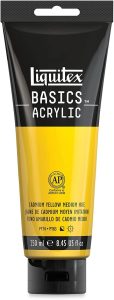
Liquitex Basics Acrylic Paint is one of the most popular and affordable options for Gelli printing. It offers a smooth consistency that works well on the Gelli plate and provides vibrant, opaque colors. This paint is great for beginners because it is easy to use, has a consistent texture, and is available in a wide range of colors.
- Advantages:
- Affordable and readily available.
- Smooth texture and good coverage.
- Opaque, vibrant colors that are perfect for bold prints.
- Dries relatively quickly, allowing for fast layering.
- Best For: Beginners and those looking for an affordable, reliable paint for their Gelli printing projects.
2. Golden Heavy Body Acrylic Paint

Golden Heavy Body Acrylic Paint is a high-quality acrylic paint that is known for its thick consistency and rich pigment. This paint has a creamy texture that allows for bold, vibrant prints with lots of texture. If you want your prints to have more depth and dimension, Golden Heavy Body Acrylic Paint is an excellent choice.
- Advantages:
- Thick, rich texture that creates more depth and texture in your prints.
- Excellent color intensity and lightfastness.
- Ideal for creating bold, opaque layers and textures.
- Best For: Artists who want to create textured prints with vibrant, long-lasting color.
3. Daler-Rowney System 3 Acrylic Paint
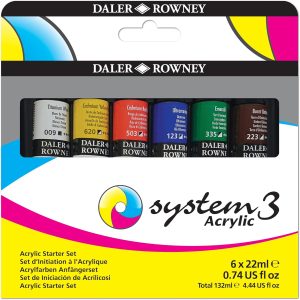
Daler-Rowney System 3 Acrylic Paint is a highly versatile acrylic paint that works well for Gelli printing. It has a smooth, creamy consistency and is available in a range of colors, including both opaque and transparent options. This paint offers a great balance between quality and affordability, making it a great option for artists of all skill levels.
- Advantages:
- Smooth consistency for easy application.
- Wide range of colors available, including transparent and opaque options.
- Quick-drying, which is great for fast printmaking.
- Best For: Artists looking for a versatile and affordable acrylic paint for various printmaking techniques.
4. Amsterdam Acrylics
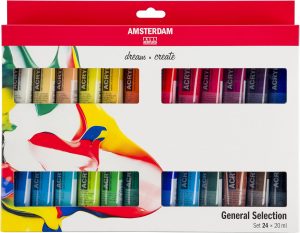
Amsterdam Acrylics are known for their vibrant colors and smooth consistency, making them a favorite among printmakers. These paints are highly pigmented and offer excellent coverage, so you can achieve both solid and translucent effects in your prints. The brand also offers different lines, such as the Amsterdam Expert Acrylics for professional-level results and the Amsterdam Standard Acrylics for a more affordable option.
- Advantages:
- Highly pigmented for rich, vibrant prints.
- Smooth and creamy texture that works well on the Gelli plate.
- Dries quickly, allowing for efficient layering.
- Best For: Artists who want high-pigment colors and versatility in their Gelli printing projects.
5. DecoArt Americana Acrylics

DecoArt Americana Acrylics are another excellent choice for Gelli printing. These paints are known for their creamy consistency and rich pigmentation. The range offers a variety of finishes, from matte to satin to gloss, allowing artists to experiment with different effects in their prints. The paints dry to a durable, flexible finish, making them perfect for both paper and fabric projects.
- Advantages:
- Variety of finishes, including matte, satin, and gloss.
- Smooth consistency that works well for layering.
- Affordable price point without compromising quality.
- Best For: Artists looking for a versatile and budget-friendly acrylic paint option for Gelli printing.
6. Matisse Structure Acrylic Paint
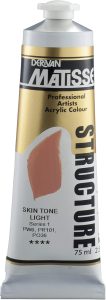
Matisse Structure Acrylic Paint is a professional-grade acrylic paint known for its thick, heavy body and high pigment content. This paint is ideal for creating textured prints, as it retains brushstrokes and creates dimensional effects on the Gelli plate.
- Advantages:
- Heavy body paint that creates texture and depth in prints.
- High pigment content for vibrant, long-lasting colors.
- Retains brushstrokes and texture, making it great for textured designs.
- Best For: Artists who want to create textured, layered prints with rich, vibrant colors.
7. Speedball Block Printing Inks
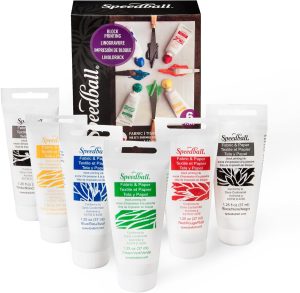
While not an acrylic paint, Speedball Block Printing Inks are a popular option for Gelli printing. These inks are designed for use with a variety of printmaking techniques and offer a creamy consistency that works well on the Gelli plate. They come in both water-based and oil-based options, giving you flexibility in your choice of medium.
- Advantages:
- Excellent for creating prints with fine details.
- Smooth, creamy texture for easy application.
- Water-based and oil-based options available.
- Best For: Artists looking for an ink-based option for detailed prints.
Tips for Gelli Printing with Paints
- Test Different Paints: Not all paints behave the same way on a Gelli plate. Experiment with different types of paint to see which one gives you the texture, opacity, and drying time you prefer.
- Use Multiple Layers: One of the unique aspects of Gelli printing is the ability to build up layers of color. Don’t be afraid to use several layers of paint to create depth and interest in your prints.
- Adjust the Consistency: If your paint is too thick, consider adding a little water or a medium to thin it out. Conversely, if your paint is too runny, you can thicken it with a gel medium to achieve the desired texture.
- Play with Tools: The Gelli plate is all about experimentation. Use a variety of tools like stencils, brushes, sponges, and stamps to add textures and details to your prints.
- Work Quickly: Some paints dry faster than others, which may impact your print’s texture. If you’re using a fast-drying paint, try to work quickly to create texture before the paint dries on the plate.
Frequently Asked Questions
- Can I use regular acrylic paint for Gelli printing?
Yes, you can use regular acrylic paints for Gelli printing, but it’s important to choose paints with the right consistency and drying time for your desired effects. Heavy-body acrylics and fluid acrylics are particularly good choices. - What’s the difference between heavy-body and fluid acrylic paint?
Heavy-body acrylics are thick and creamy, providing texture and body to your prints. Fluid acrylics are more runny and are ideal for smooth, thin layers. Both types can work for Gelli printing, but heavy-body paints are better for creating texture. - Do I need to use a specific kind of paper for Gelli printing?
No, you can use a variety of papers for Gelli printing, including mixed-media paper, watercolor paper, and even fabric. Just ensure the paper is thick enough to handle the paint without tearing. - Can I use watercolor paint for Gelli printing?
Watercolors can be used, but they may not create as much texture as acrylics. If you use watercolor, you may want to add a thicker layer or combine it with other mediums for a richer effect. - How long does it take for the paint to dry on the Gelli plate?
Drying time varies based on the type of paint you use. Most acrylic paints dry quickly, but thicker paints or paint layers may take longer. Always check the paint manufacturer’s guidelines for specific drying times. - Can I mix different brands of paint for Gelli printing?
Yes, you can mix different brands of paint as long as they have a similar consistency. Mixing brands can lead to interesting results, but be mindful of how each paint behaves to ensure good adhesion and texture. - What’s the best way to clean the Gelli plate after printing?
After each printing session, clean the Gelli plate by gently wiping it with a damp cloth or using baby wipes. For stubborn paint, you can use a mild soap solution to clean it thoroughly.
Conclusion
Choosing the best paint for Gelli printing can greatly influence the quality and uniqueness of your prints. Whether you’re using thick, heavy-body acrylics for texture or fluid acrylics for smooth layers, the right paint will help you achieve your desired artistic results. By experimenting with different paints, tools, and techniques, you can unlock endless possibilities in your Gelli printing projects.

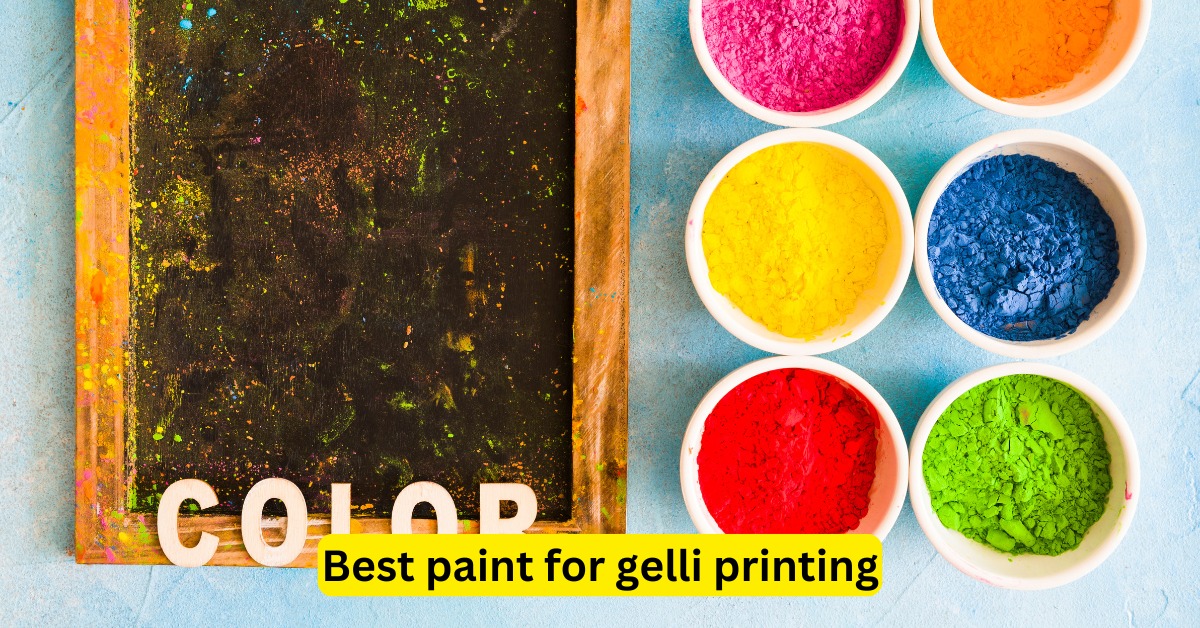
Leave a Reply